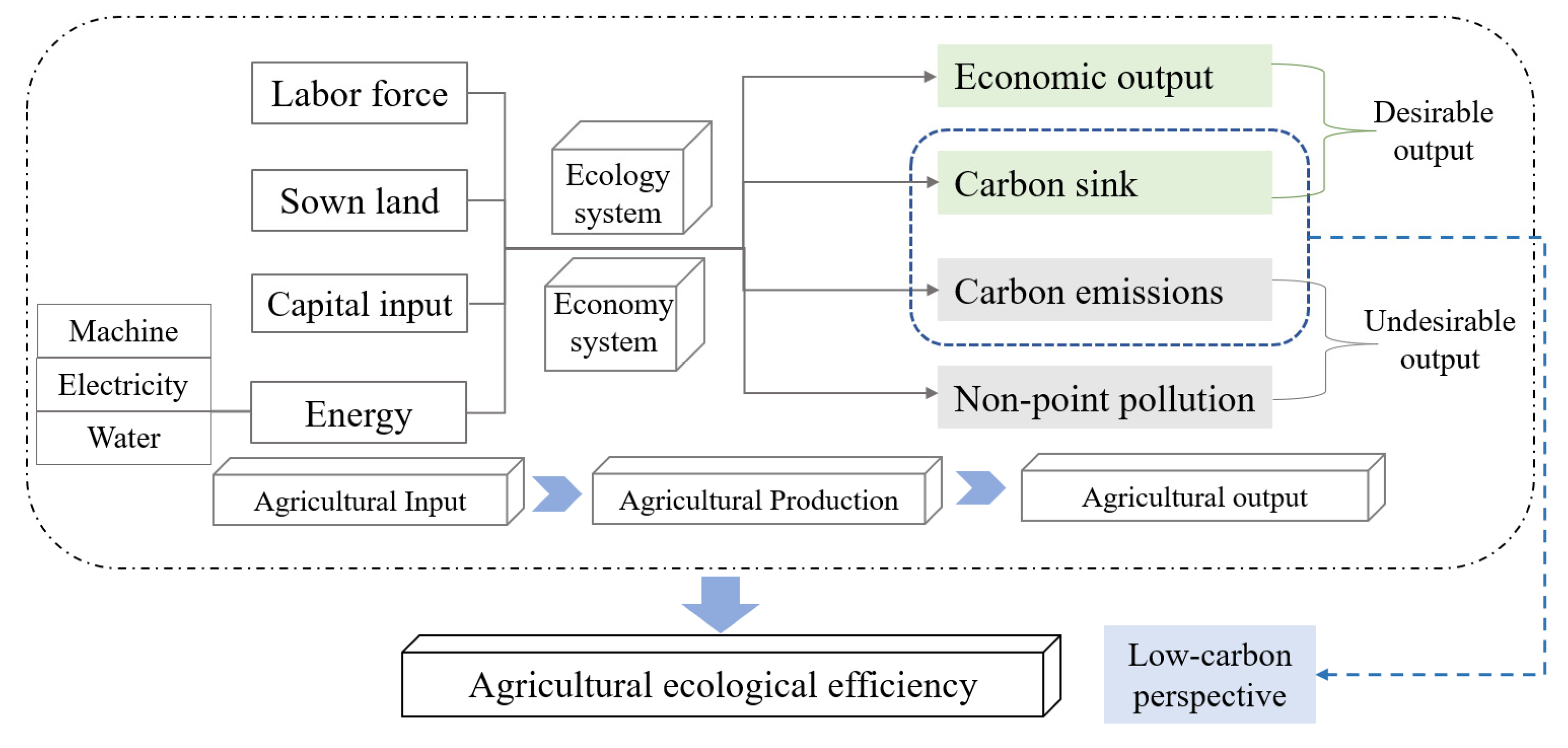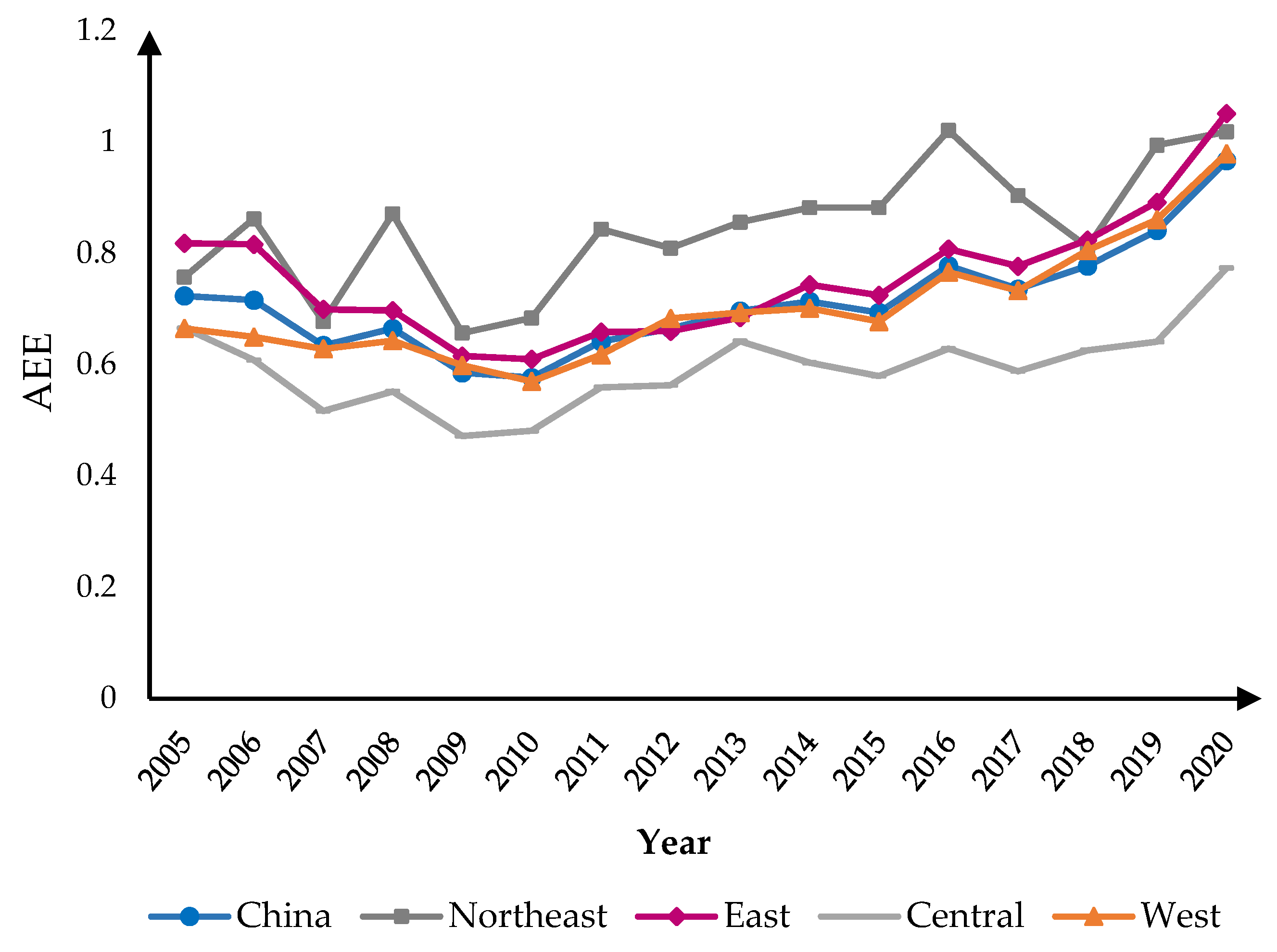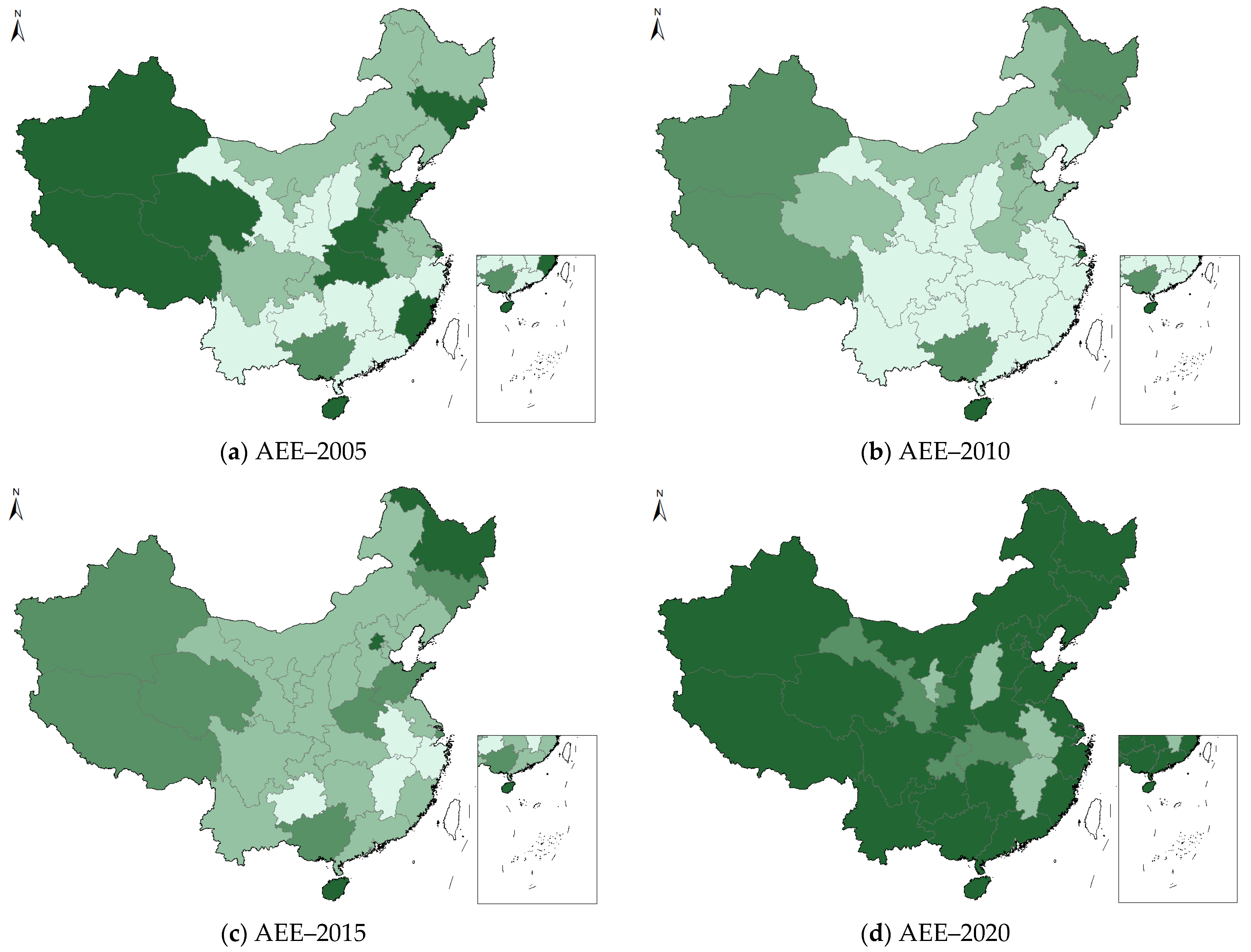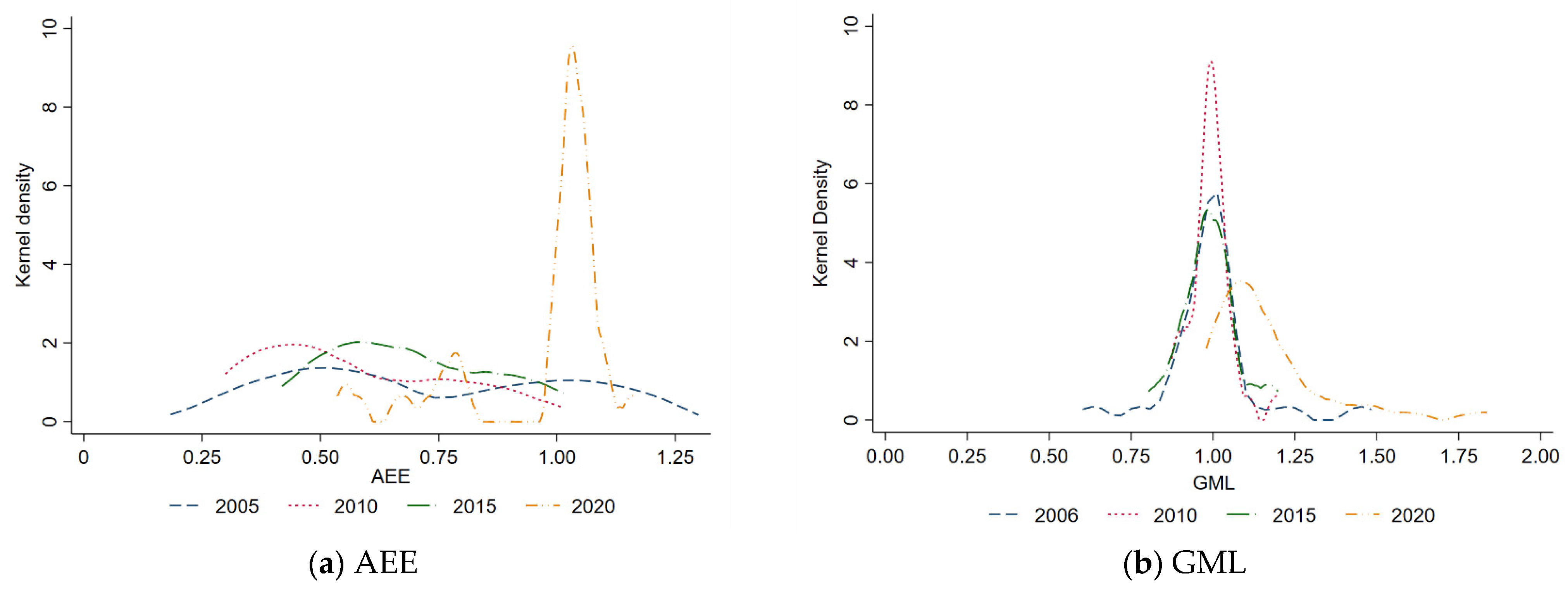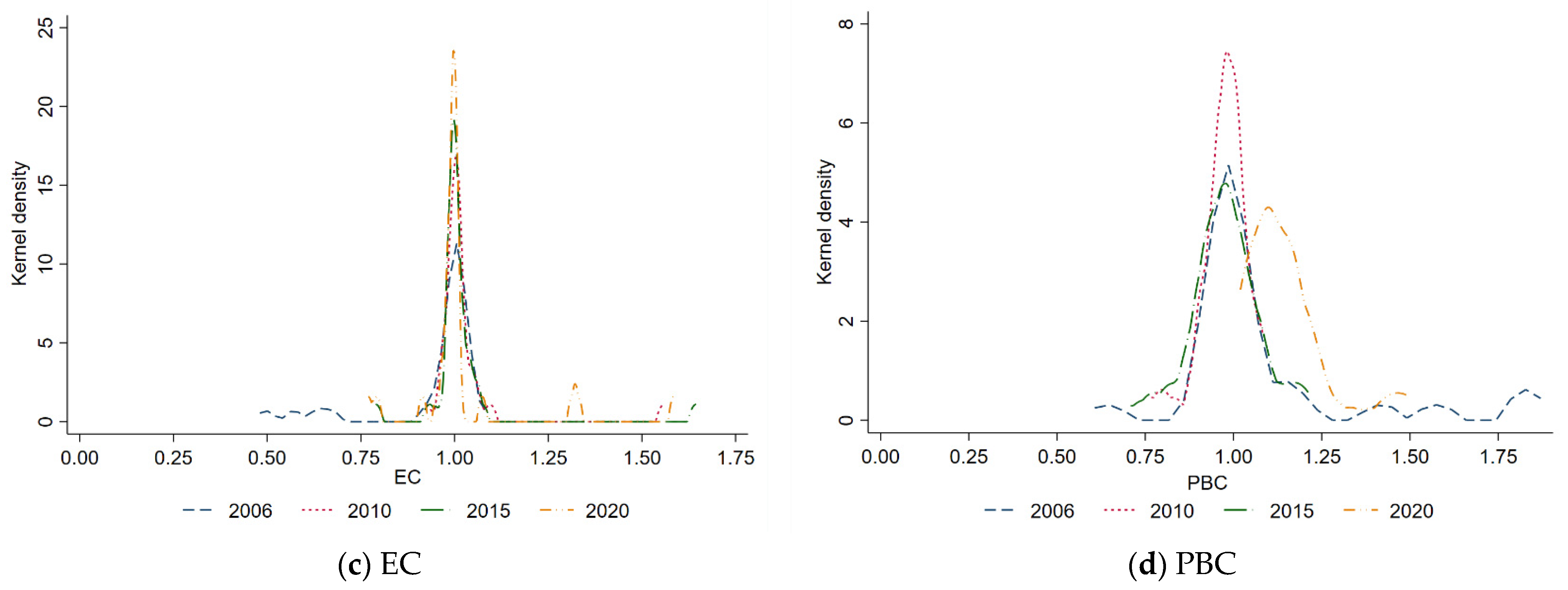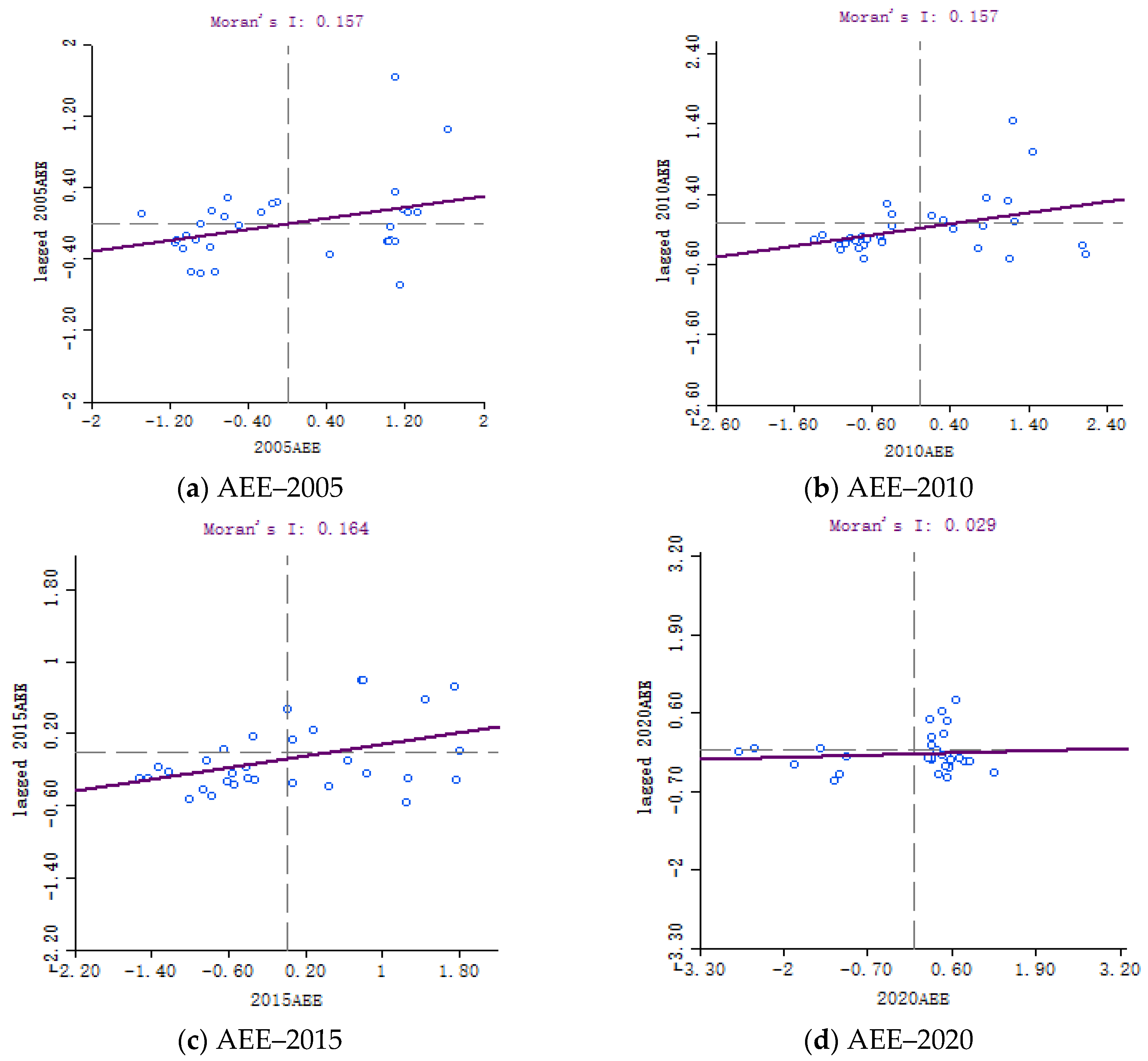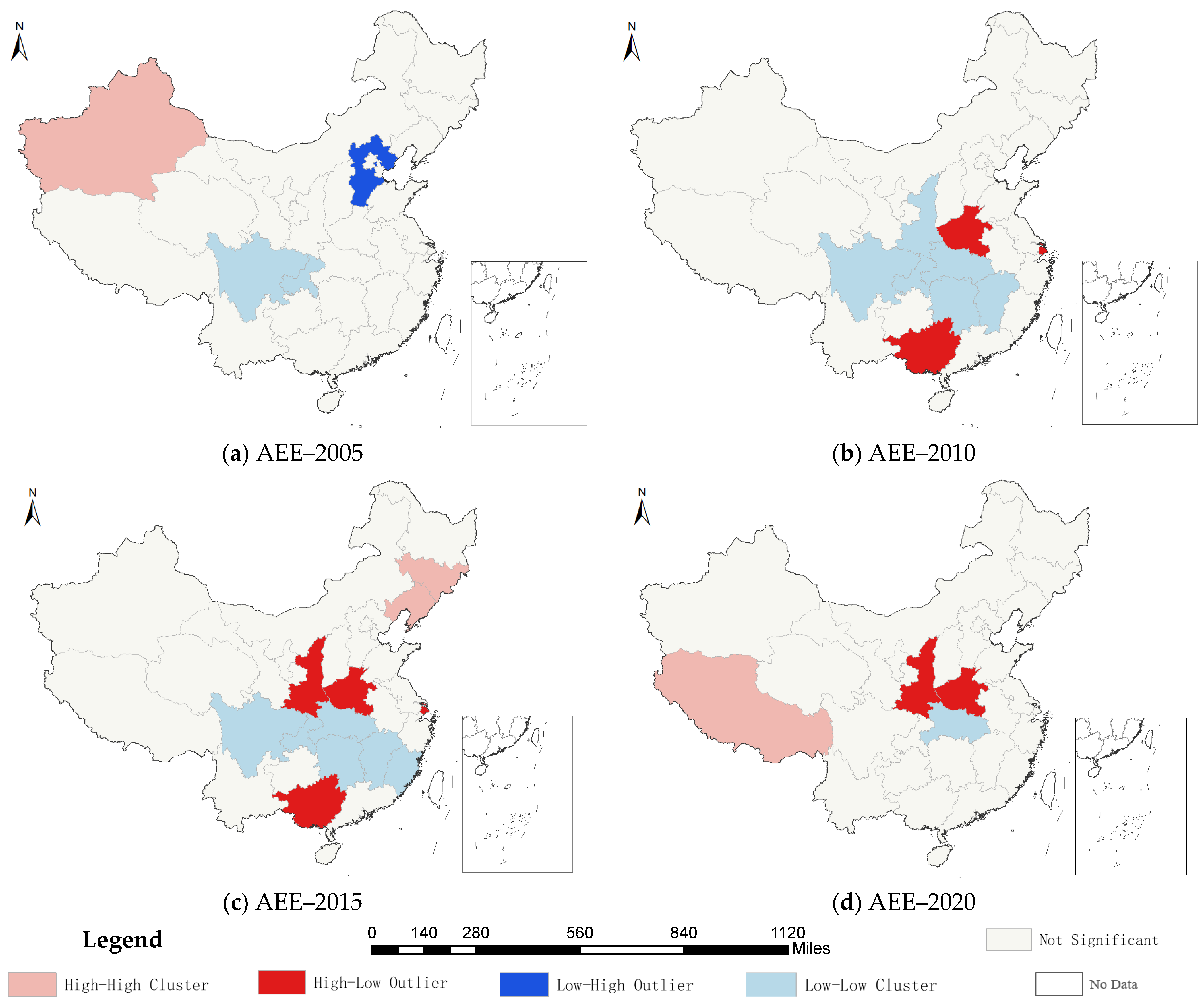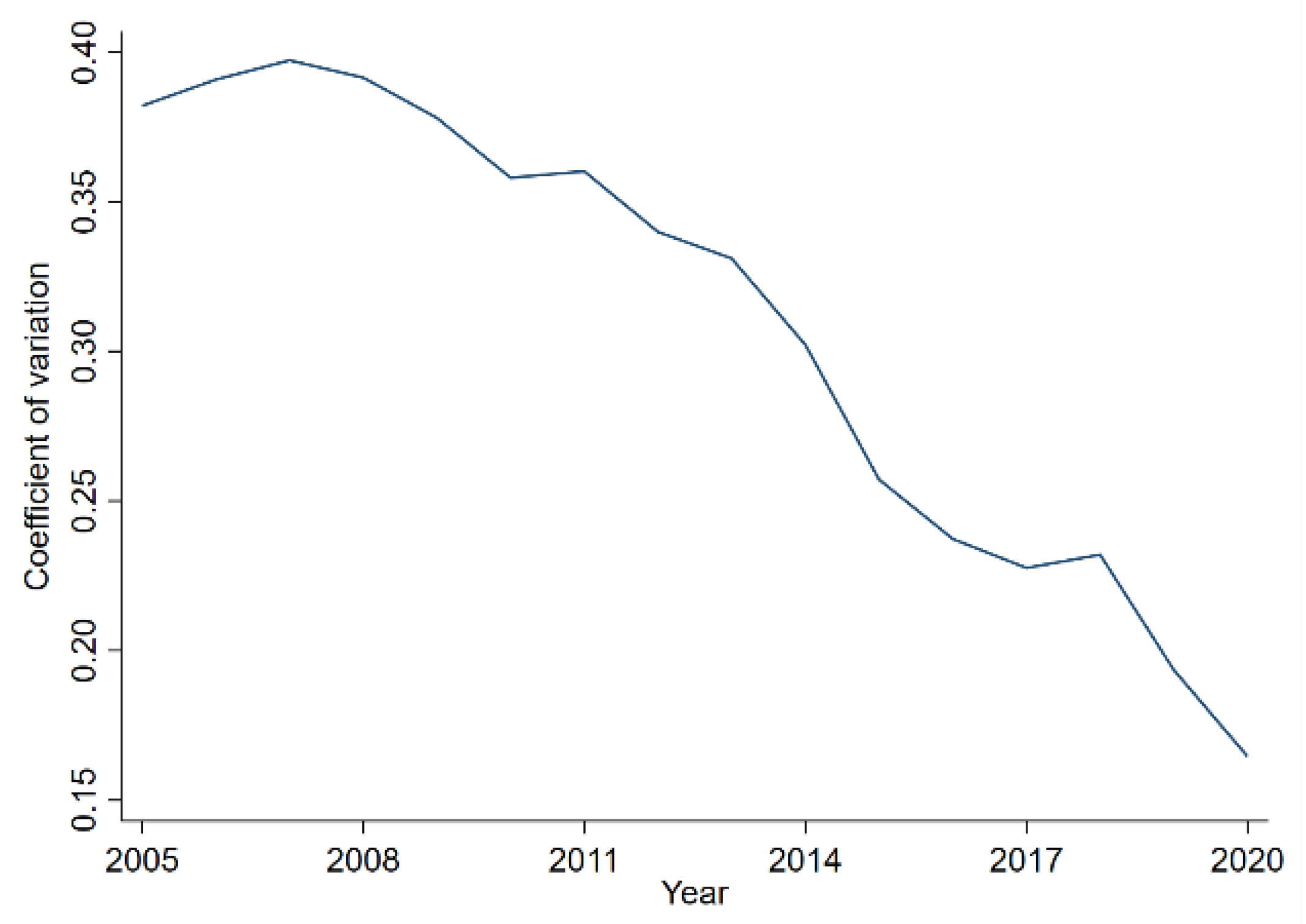4.1. Static AEE Evaluation
Based on the above methods, the 2005 to 2020 AEEs in 31 Chinese provinces (cities) were calculated using MATLAB software, the results of which are shown in
Table 3.
From 2005 to 2020, the provincial AEE in China ranged from 0.2839 to 1.1741 and had large time and regional dimensional differences. The eco-efficiency distribution in each region is shown in
Figure 2.
China’s AEE first decreased and then increased, with the inflection point occurring in 2010, that is, the AEE development was U-shaped.
During the 11th Five-Year Plan period (2006–2010), as the dominant agricultural development philosophy in this period was aimed toward improving agricultural productivity and value-added capacity, the agricultural output-per-unit area and the intensification degree were low. During the 12th (2010–2015) and the 13th Five-Year Plans (2016–2020), the AEE was in an upward phase and grew faster in the latter five years. The AEE rise from 2011 to 2015 was mainly due to comprehensive rural environmental improvements, agricultural nonpoint source pollution prevention projects, and scientific guidance on the use of fertilizers and pesticides, all of which effectively promoted agricultural development, environmental protection, and energy conservation. During the 13th Five-Year Plan period, zero-growth fertilizer and pesticide-use actions and recycling agriculture combined with planting and raising projects were also implemented.
Of the four major regions, the eco-efficiencies in the northeast fluctuated slightly but were at the highest overall level, followed by the eastern region. The western region had more synchronized and slightly lower growth dynamics than the eastern region, and the AEE in the central region was the lowest, which was similar to the findings in [
8,
15].
The northeast region had an inherent resource advantage because of its fertile black soil. China’s grain production in 2021 was 685.58 billion tons, 21.2% of which was produced in the northeast [
65], implying that this region had a high carbon sink for crops returned to the land. The large-scale agricultural intensification in the northeast also improved output efficiency. However, as agricultural production is relatively sensitive to climate, policy, and economic conditions, the northeast AEE fluctuated widely [
5].
The eastern region is the most economically developed in China, with a high degree of industrialization and a more serious occupation of agricultural land resources. However, according to
Table A3, the east had higher agricultural machinery power, irrigation area, and power usage redundancy ratio and a higher undesirable output redundancy ratio of carbon emissions and nonpoint source pollution. Therefore, its resource utilization was inefficient, which resulted in excessive carbon emissions and agricultural pollution. Therefore, the economic resource advantages of the eastern region were not fully reflected in its green agricultural development.
The western region’s efficiency had similar redundancies to the eastern region. However, it had the highest labor and crops-sown area redundancy ratio of the four regions (see
Table A3), primarily related to its economic, geographic, and population backgrounds. Although the western region covers a large area, the agricultural farming conditions in the west are poorer than in other regions. Mechanization is low and labor is an important production factor, all of which contributed to the higher workforce and land redundancies.
Aside from rural electricity consumption, labor input, land input, and total agricultural output, the central region’s input and undesirable output redundancy rates were the highest of the four regions (see
Table A3), indicating that the central region had significant agricultural materials, water, and land inefficiencies [
8]. Additionally, its carbon sink insufficient rate was also the highest, indicating that a high carbonization of agricultural development was evident.
For a more intuitive reflection of the comparative AEEs in different regions and their respective development trends, a hierarchical map (
Figure 3) was drawn using ArcGIS.
When the mean efficiencies in each province were ranked, the five highest AEE provinces were Beijing (E), Shanghai (E), Hainan (E), Xinjiang (W), and Inner Mongolia (W), and the five lowest were Jiangxi (C), Zhejiang (E), Anhui (C), Chongqing (W), and Guizhou (W). The best- and worst-performing regions did not show agglomeration, which indicated that there were large intra-regional variations.
Zhejiang Province had the highest average annual growth rate (8.51%). Before 2017, Zhejiang province had inefficient energy utility, excessive carbon emissions, and a low carbon sink value. However, after the optimization of these aspects, an effective state was attained in 2020. In contrast, the lowest average growth rate was in Hubei province (−1.62%), primarily because of the lack of improvements in its agricultural input and output structures.
4.2. Dynamic AEE Evaluation
4.2.1. Dynamic AEE Growth Rate
The dynamic AEE changes in the 31 provinces were evaluated and analyzed using the GML index. Due to the growth calculations involved, only 15 periods were evaluated over the 16 years, the results for which are shown in
Table 4 and
Table 5.
GML index phase characteristics and component changes.
From 2005 to 2020, the average annual growth in the GML, PBC, and EC indices was 2.35%, 2.24%, and 0.1%, respectively. After a decline of 4.15% during the 11th Five-Year Plan period, annual GML index growth in the 12th and the 13th Five-Year Plan periods was 4.33% and 7.20%, respectively.
The main driving force for the AEE changes was technological progress. The Chinese government has always attached importance to developing agricultural science and technology [
66]. Before 2010, government-led agricultural information technology guided production through information dissemination. After 2010, “internet plus agriculture” became dominant, and technologies such as agricultural e-commerce, the agricultural Internet of Things, and agricultural traceability were oriented toward market transactions and broadened agricultural product sales. More recently, artificial intelligence has been gradually applied to agriculture, such as seed detection, intelligent planting, crop monitoring, and soil irrigation, to improve agricultural production efficiencies and reduce costs. Statistically, mechanized farming has advanced significantly to 69.1%, and the rural internet penetration rate had improved from 0 to 38.4% by 2018. During the 13th Five-Year Plan period, the agricultural science and technology contribution rate exceeded 60% [
67]. However, China’s agricultural digital technology has only been applied in a few fields, so there is significant room for improvement.
Interregional GML index characteristics and its component changes.
The average annual eco-efficiency growth rates in the northeast, eastern, central, and western regions were 2.22%, 2.25%, 1.23%, and 3.02%, respectively, of which the PBC contributed 1.95%, 1.72%, 2.38%, and 2.68%, respectively, and the EC contributed less than 0.6%. The EC in the central region reduced by 1.2%, indicating that the input factor coordination was not high, and its technical potential was not yet realized.
The Chinese provinces were classified into three categories based on reasons for the eco-efficiency changes. The first category included provinces in which technical efficiency played a major role: Beijing, Tianjin, Hebei, Qinghai, and Ningxia. These four provinces had an average EC greater than 1 but a PBC of less than 1. The second category comprised provinces in which both technical efficiency and technological progress played joint roles, Heilongjiang, Fujian, and Yunnan, and both EC and PBC positively contributed and had similar effects on the eco-efficiency dynamics. The third category involved provinces where technological progress played a dominant role, with all the remaining 23 provinces falling into this category. While the AEE drivers were found to vary in the Chinese provinces, technological progress was the predominant driver, indicating that the technical efficiency drivers played relatively minor roles and existing resource allocation and coordination approaches need to be urgently optimized to enhance resource utilization efficiencies.
4.2.2. Kernel Density Estimation of AEE
Figure 4a shows the results for the kernel density AEE estimations. From the density function center (the value corresponding to the horizontal coordinate), the kernel value in 2020 was the largest, indicating that the average AEE in 2020 was the highest in four years. Aside from that of 2010, the kernel density distribution curves all showed a flattening trend to the right, revealing an AEE trend from decline to rise. The peak density center value in 2020 was more prominent and had a longer tail on the left side, showing that more provinces were nearer to the average value and there were greater efficiency variations in the provinces below the mean. There was only one evident peak in 2020, but in 2005, 2010, and 2015, there were double peaks and the curves were flatter. Therefore, the AEE distribution was characterized by an overall dispersion and concentration in individual years.
Figure 4b–d show the GML, EC, and PBC distributions. The GML and the PBC index kernel density curves were similar, the overall distribution was more concentrated in 2005, 2010, and 2015, and the density function center shifted significantly to the right in 2020, indicating that both the GML and PBC indices increased significantly in 2020. The GML and PBC indices showed significant single-wave crest conditions at 1 in 2006, 2010, and 2015, that is, their mean values were concentrated around 1. However, in 2020, there was a clear single-wave peak with a long right tail, which suggested that more provinces were concentrated near the mean and the eco-efficiency differences in the provinces above the mean were widening.
The technical efficiency (EC) kernel density distribution curve was concentrated around 1 and had little variation over the years. All four years had significant single-wave peak conditions, with the wave height increasing each year, which illustrated that the technical efficiency distribution concentration was increasing and there were few inter-regional variations.
In summary, there were more obvious eco-efficiency growth trends, with the eco-efficiency moving from being decentralized to being centralized. The growth rate for the AEE (GML) and technical progress (PBC) moved from being centralized to being dispersed and the regional differences were enhanced, with the technical progress being more evident in some provinces. The technical efficiency (EC) distribution was more concentrated, and the change magnitude was small. Therefore, the kernel density estimation once again verified that the main contribution to the AEE changes was related to the increase in technical progress.
4.3. Spatial Distribution Characteristics of AEE
The exploratory spatial data analysis (ESDA) focused on the spatial autocorrelation of the AEE. The global Moran index (
Table 6), the local Moran scatterplot (
Figure 5), and the local indicators of spatial association (LISA
Figure 6) for AEE from 2005 to 2020 were determined using ArcGIS.
Table 6 shows that the global Moran index for China’s AEE from 2005 to 2019 ranged from 0.0839 to 0.2994, all of which were significant at least at the 10% level. Although the degree of spatial correlation varied, there were always significant spatial effects, which indicated that the Chinese provincial AEEs had significant positive spatial correlations. The eco-efficiency was possibly influenced by spatial spillovers from neighboring provinces, that is, there was a demonstration effect. However, the Moran’s I for 2020 was insignificant, meaning there were no significant spatial autocorrelations.
To clarify the association characteristics of each province to its neighboring provinces, a Moran scatter plot and a LISA agglomeration plot were constructed to reveal the local association patterns.
Figure 5 shows that China’s AEE was mainly concentrated in the first quadrant (H-H clustering), the third quadrant (L-L clustering), and the fourth quadrant (H-L clustering).
According to
Figure 6, in 2005, the main distribution features were H-H clustering (Xinjiang) and L-L clustering (Sichuan and Chongqing), both in the western region. These patterns illustrated that the agricultural technology and the input-output structures in neighboring provinces gradually converged, meaning there were fewer spatial differences [
4]. Hebei had L-H clustering, probably because the unidirectional flow of Hebei’s resources to Beijing and Tianjin led to a lack of technical and agricultural talent development support, which regressed the ecological efficiency.
In 2010, the L-L and H-L agglomerations were significant. Compared with 2005, the L-L zone expanded and formed a contiguous trend to span three regions from the east to the west, including Shaanxi, Chongqing, Hunan, Hubei, Jiangxi, and Fujian. This outcome indicated that, because rapid urbanization had reduced the availability of high-quality arable land, agricultural development became more focused on yield but neglected sustainable development. The H-L agglomeration was mainly distributed in Guangxi, Henan, and Shanghai, indicating that the high center region AEE had exerted a siphoning effect on the surrounding disadvantaged areas, which widened the gaps with the neighboring provinces.
In 2015, Shaanxi Province shifted from an L-L to an H-L agglomeration, Jilin and Liaoning showed significant H-H agglomeration, Sichuan Province returned to a significant L-L clustering, and Hebei Province moved away from an L-L agglomeration. The possible reasons for these changes were that Shaanxi Province, with the help of western development and the Belt and Road Strategy, had policy advantages and had prioritized green transformation; however, Sichuan and its neighboring provinces had less collaborative capacity and had not realized any complementary agricultural production advantages. In contrast, the Beijing-Tianjin-Hebei region’s strategy that was focused on collaborative pollution control had enhanced overall low-carbon agricultural development.
In 2020, the AEE distribution was mainly dominated by H-H, H-L, and L-L clustering. As Tibet (H-H clustering) is an important ecological security barrier in China, the government has attached importance to its ecological construction. Consequently, to keep Tibet one of the best ecological regions in the world, a good green agricultural development foundation has been built. H-L clustering was found mainly in Shaanxi and Henan, but Hubei province still had an L-L agglomeration.
4.4. Convergence Analysis of AEE
convergence was measured using the coefficient of variation, the results of which are shown in
Figure 7. The AEE coefficient of variation fluctuated and decreased from 2005 to 2020, which indicated that the AEE differences between the provinces were narrowing.
Table 7 shows that the initial AEE for the β absolute convergence model was significant at a 5% confidence level, and the AEE coefficient was less than 0.
The control variables, rural household per capita disposable income (dpi), total mechanical power per unit area (mech), the percentage of area affected by natural disasters (haz), and digital concern (digit), were applied in the conditional β convergence model, with the dpi being adjusted using the agricultural product price index, and the dpi, mech, and digit being logarized. Similarly, the initial AEE for the conditional β convergence model was significantly negative at the 1% level, and the convergence rate was accelerated (0.3490 > 0.2078), which demonstrated that the AEE in the Chinese provinces was converging to the same level and there was a catch-up effect.
There was a significant positive relationship between rural households’ per capita disposable income and the AEE changes. Higher disposable income ensures that agricultural producers have access to more agricultural production resources, such as capital and farming tools, which enhances their agricultural productivity. Higher income also facilitates agricultural producers to pay greater attention to the production and consumption of green products, which directly or indirectly promotes AEE improvements. The impacts of agricultural mechanization and the affected area percentage on the AEE were negative and significant at 1% and 5%. There were several reasons for these results. First, agricultural machinery inputs amplified diesel and gasoline consumption, which increased both carbon emissions and agricultural pollutants [
13]; an over-reliance on mechanical power to exploit land potential without incorporating arable land systems, such as fallow or shifting cultivation, can be detrimental to AEE improvements. Second, any expansion of the affected agricultural areas could lead to insufficient output, wasted inputs, and a reduction in AEE [
64]. The effect of local governments’ digital technology attention on AEE was positive but not significant, which suggested that technological attention has not yet become an important driver of green agricultural production and consumption.
